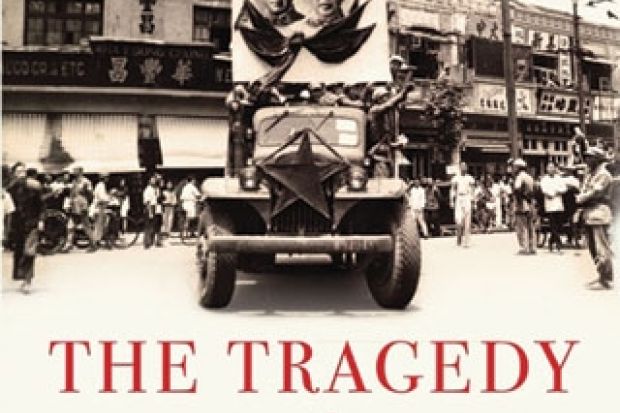In 1644, Li Zicheng proclaimed the Shun dynasty’s rule over China. He and his rebel forces had conquered the capital of Beijing that year and overthrown the once-powerful Ming dynasty. Terrified of falling into rebel hands, the last Ming emperor hanged himself from a tree. The brief rule of the Shun, however, was marked by internal power struggles, executions of allegedly disloyal bureaucrats, corruption, torture, rape and pillaging. Soon, the Manchu armies drove the Shun out and proclaimed the Qing, China’s last imperial dynasty.
Three hundred and five years after Li’s troops marched into the imperial capital, Mao Zedong arrived in Beijing, the city about to become the political centre of the new People’s Republic of China. Chatting to Zhou Enlai, Mao shrewdly noted that the Chinese Communist Party could not afford to repeat Li’s mistakes. They would have to know better.
As The Tragedy of Liberation forcefully argues, the Chinese Communist leaders in many ways did not know better. Violence, terror and corruption were among the hallmarks of Communist rule after 1949. Yet, in a twist of irony, this new Communist “dynasty” was to survive, despite and at the same time also because of its ability to repress and control.
Referring to the campaigns as a ‘Great Terror’ suggests the Chinese experience gains relevance by association with more familiar Western historical narratives
Frank Dikötter’s latest book is the second instalment of his People’s Trilogy, following the prizewinning Mao’s Great Famine. This new volume narrates the history of events leading up to the man-made catastrophe known as the Great Leap Forward, which ravaged the countryside between 1958 and 1962 and which Dikötter estimates cost the lives of more than 45 million people.
Based on extensive and fascinating new archival evidence, this second book is a compelling and devastating account of the Communist involvement in the Civil War and of the first eight years of Communist rule. After 1949, a succession of rural and urban mass campaigns targeting landlords, rich peasants, counterrevolutionaries, capitalists, intellectuals, rightists and many more kept the country in a vicious cycle of revolutionary fervour, mutual accusations, controlled and uncontrolled violence and everyday terror. Ideological re-education, criticisms and self-criticisms turned into rituals of survival, legitimation and – for many – destruction and death. Increasing production became the mantra of those ruling, the maxim of those labouring, and the nemesis of those oppressed. Famine was the result of utopian policies, statistical calculations and utter disregard for the needs of the very “masses” the party-state had pledged to liberate. Language was developed into a formalised weapon, used to bring in line or purge among and outside the party ranks. Freedom of speech, although enshrined in the 1954 constitution, was a matter of interpretation, while freedom of silence was seldom granted.
The Mao era, and especially its first eight years, was one of promises and disillusions, utopian idealism and callous pragmatism. It saw horrific human tragedy and incalculable human loss. It was also an era that many who lived through it remember today with mixed feelings ranging from dread to a puzzling nostalgia. This, in essence, is the dilemma the historian of China’s recent past faces. How do we make sense of this turbulent half century? And how do we call attention to the inhumane atrocities committed and the crucial importance of universal moral imperatives, while not losing sight of the diversity of individual historical experiences? The Tragedy of Liberation is a major contribution to this ongoing conversation among historians, social and political scientists and other academics, all of whom seek to bring to light, often by way of extensive archival evidence, the human dimensions of the Communist takeover. They all grapple with what Jeremy Brown and Paul Pickowicz have aptly termed the “dilemmas of victory”.
I would quibble, however, with some of the terms Dikötter employs. Referring, for instance, to the campaigns as a “Great Terror” and to labour camps as “gulags” implicitly suggests that the Chinese experience gains relevance by association with more familiar Western historical narratives. Although some contemporaries used these terms for exactly that reason, this book might have been an opportunity to promote a broader understanding of a less common vocabulary specifically relevant to Mao-era China.
Overall, though, this is a gripping and fluidly written account of the first decade of the People’s Republic of China; one that contributes to bringing Chinese history into popular discussions of 20th-century international revolutions, utopianism, violence and terror.
The Tragedy of Liberation: A History of the Chinese Revolution 1945-57
By Frank Dikötter
Bloomsbury, 400pp, £25.00
ISBN 9781408837573
Published 29 August 2013
Register to continue
Why register?
- Registration is free and only takes a moment
- Once registered, you can read 3 articles a month
- Sign up for our newsletter
Subscribe
Or subscribe for unlimited access to:
- Unlimited access to news, views, insights & reviews
- Digital editions
- Digital access to THE’s university and college rankings analysis
Already registered or a current subscriber? Login




